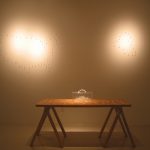- Clear Tooling
- Installation view
R E C E N T V I S I O N S
University Art Gallery, Staller Center for the Arts, Stony Brook University Stony Brook, New York, 2004
cast, crystal, pyrex, wood
Transparent glass hammers made out of crystal, though part of a larger installation work, stand on their own as challenging objects. Tools, often considered crucial to human evolution, play a complex and ambiguous role in life—bullets kill yet protect, atomic fusion brings energy and mass destruction, hammers build and destroy. Yet what defines the object, its role, and the (human/art) acts of making and using it—material, shape, opacity, hardness, use, intention, beauty…?
Diagrammatic wall maps, made of hammered nails, represent both the United States—site of the work and its conception—and Iraq—site not only of the “fate” of our tools, but also of the supposed origin of civilization’s greatest tool, written language (Babylon, circa 6000 BC). Tools create, reveal, excavate, preserve, record, interpret, and manipulate history (“our story”), and they do it by the tool’s inherent capacity to serve also as sign, symbol, metaphor, art, even sacralized object. The tools that do our work and our dirty work cannot see themselves, but we can see them and ourselves and even “see through” them and ourselves.
Glass is both one of mankind’s most ancient materials and itself a tool. When annealed, glass is a fluid material that can be either transparent or translucent depending on the crafting method. For this series, Nagasawa chose crystal, a type of glass that contains a high percentage of lead, which makes the glass flow and achieve an optical clarity when polished. Lead (like glass and indeed all materials) is inherently ambiguous—a poisonous, potentially fatal substance that is also the only material that protects from radiation. Raw materials become the tools with which we make tools; materials and tools determine and reflect each other; and they determine and reflect the lives and histories of those who make them. Art itself is a tool by which this complex situation is rendered “clear” and open to further reflection.


